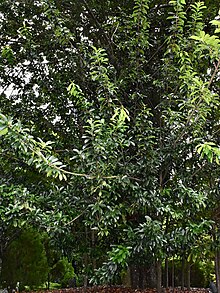Pentadesma butyracea
This article includes alist of references,related reading,orexternal links,but its sources remain unclear because it lacksinline citations.(March 2020) |
| Pentadesma butyracea | |
|---|---|

| |
| Scientific classification | |
| Kingdom: | Plantae |
| Clade: | Tracheophytes |
| Clade: | Angiosperms |
| Clade: | Eudicots |
| Clade: | Rosids |
| Order: | Malpighiales |
| Family: | Clusiaceae |
| Genus: | Pentadesma |
| Species: | P. butyracea
|
| Binomial name | |
| Pentadesma butyracea | |
| Synonyms[2] | |
Pentadesma butyraceais a tree native to the forests of tropical Africa fromSierra LeonetoCameroon.It has multiple uses, the main one being the manufacture of a kind of butter called "kpangnanbutter "similar toshea butter.Thetimberis used incabinetmakingand construction.
It is sometimes calledAfrican butter tree.
Description
[edit]Pentadesma butyraceahas a straight, cylindricalbolewithoutbuttressand an average height of 20m..It bears large bright red flowers, giving edible berries whose seed is used to make butter.
The flowers of the butter tree are pollinated by theWoermann's bat.
Uses
[edit]The seeds are used to make kpangnan butter also calledpainya,kanyainBenin,Kangain Sierra Leone,AkpotoinTogoamong others. This butter can be stored for one to three years without going rancid.
Kpangnan is traded locally, particularly in central Togo and Benin. It is occasionally sold in the US and Europe as "yellow shea butter", In reality, shea butter and kpangnan are extracted from two different tree species and have noticeably different scents, appearances and textures. A feature unique to kpangnan butter is its highstigmasterolcontent (around 45% of thesterolcontent). Stigmasterol is the sterolunsaturatedvegetable fat usually found in plant parts such ascalabar bean,soybean oil,rapeseed oil,andcocoa butter.Stigmasterol is used as a base material in the production of syntheticprogesterone,but has other interesting properties. Research shows that stigmasterol can reduce the risk of certain cancers, including ovarian cancer.[citation needed]
Like shea butter, kpangnan has been harvested in West Africa for generations. It is used in cosmetics (for hair, to moisturize the skin), as edible oil, and for the manufacture of traditional soaps.
References
[edit]- "Vol. 1, No 1 (2007) – Résumés en Français – Impact du ramassage des fruits de Pentadesma butyracea sur sa régénération naturelle et analyse financière de la commercialisation de ses produits au Bénin – Notes du Laboratoire d'Ecologie Appliquée".Archived fromthe originalon 2 March 2009.Retrieved3 March2020.</ref> Impact du ramassage des fruits de Pentadesma butyracea sur sa régénération naturelle et analyse financière de la commercialisation de ses produits au BéninArchived2 March 2009 at theWayback Machine
- Etude de la Faculté des sciences agronomiques, Université d’Abomey-Calavi-Bénin[permanent dead link]
- ^Sabine, Joseph. Transactions of the Horticultural Society of London 5: 457. 1824
- ^"Pentadesma butyraceaSabine ".Plants of the World Online.Archivedfrom the original on 5 February 2020.Retrieved5 March2020.
